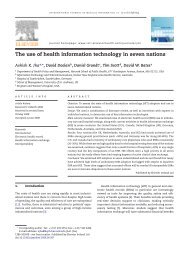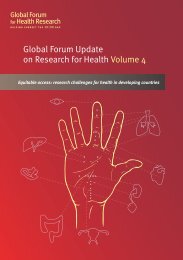At the Intersection of Health, Health Care and Policy doi: 10.1377 ...
At the Intersection of Health, Health Care and Policy doi: 10.1377 ...
At the Intersection of Health, Health Care and Policy doi: 10.1377 ...
- No tags were found...
Create successful ePaper yourself
Turn your PDF publications into a flip-book with our unique Google optimized e-Paper software.
Comprehensive<strong>Care</strong>dundancy, overlap, <strong>and</strong> waste. Finally, <strong>the</strong> sole emphasis on women <strong>and</strong> youngchildren, to <strong>the</strong> neglect <strong>of</strong> o<strong>the</strong>r segments <strong>of</strong> <strong>the</strong> population, is an important flaw.The high burden <strong>of</strong> HIV/AIDS among people ages 20–39 in many developing countries(an indication <strong>of</strong> infection during adolescence) is not surprising, given <strong>the</strong>long neglect <strong>of</strong> this population group in health policy <strong>and</strong> practice. 20 Improvements <strong>and</strong> deficits in global health. In spite <strong>of</strong> <strong>the</strong> above shortcomings,selective primary health care has been lauded as having contributed greatly toimprovements in global health. It is said, for example, that eight <strong>of</strong> every ten childrenin <strong>the</strong> world today receive vaccinations against <strong>the</strong> five major childhood diseases. 21Globally, between 1980 <strong>and</strong> 1993 infant mortality fell by 25 percent, while overall lifeexpectancy increased by more than four years, to sixty-five years.However, whereas <strong>the</strong> number <strong>of</strong> children under age five who died from vaccine-preventablediseases decreased by 1.3 million between 1985 <strong>and</strong> 1993, morethan twelve million <strong>of</strong> <strong>the</strong>se children died within this period never<strong>the</strong>less. Of thisfigure, vaccine-preventable diseases still accounted for 2.4 million deaths. Moreover,childhood diarrhea <strong>and</strong> malnutrition remain leading causes <strong>of</strong> impaired childhealth in developing countries, contributing greatly to <strong>the</strong> thirteen million deathsthat occur annually among children under age five. 22A 2003 United Nations report argues that international assistance aimed a<strong>the</strong>lping poorer countries develop is failing; it calls for a reexamination <strong>of</strong> currentstrategies if <strong>the</strong> world is to meet targets for reducing poverty, hunger, <strong>and</strong> illness. 23According to <strong>the</strong> report, fifty-four countries are poorer now than <strong>the</strong>y were in1990, <strong>and</strong> life expectancy has regressed in thirty-four countries, mostly in Africa.Lessons For Future Global <strong>Health</strong> <strong>Policy</strong>Although disease-specific interventions are important, assuring real changewill require attention to environmental, political, <strong>and</strong> social actions that target<strong>the</strong> root causes <strong>of</strong> disease as envisaged at Alma <strong>At</strong>a. Alma <strong>At</strong>a’s comprehensive primaryhealth care was a global recognition <strong>of</strong> some <strong>of</strong> <strong>the</strong> causes <strong>of</strong> unsatisfactoryresults in many programs. 24 Studies during <strong>the</strong> 1970s revealed that lack <strong>of</strong> overalldevelopment was inextricably linked to health <strong>and</strong> that health discussed in a vacuumwould never succeed. However, experimentation with comprehensive <strong>and</strong>selective approaches to global health policy have also revealed that discussion <strong>of</strong>health in <strong>the</strong> context <strong>of</strong> society, economics, politics, <strong>and</strong> development put manybarriers in <strong>the</strong> way <strong>of</strong> success as well.One <strong>of</strong> <strong>the</strong> ideological barriers was <strong>the</strong> concomitant challenge <strong>of</strong> social equity<strong>and</strong> social justice. Alma <strong>At</strong>a made it <strong>the</strong> responsibility <strong>of</strong> governments <strong>and</strong> agenciesto promote equity <strong>and</strong> ensure that certain citizens were not unduly sufferingfor <strong>the</strong> benefits received by o<strong>the</strong>rs. Comprehensive primary health care combinedmany complex features into its definition <strong>of</strong> health <strong>and</strong> health care. Various sectors need to work toge<strong>the</strong>r. First, because health does not occurin isolation, <strong>the</strong> various sectors, including those within a national government <strong>and</strong>HEALTH AFFAIRS ~ Volume 23, Number 3 171Downloaded from content.healthaffairs.org by <strong>Health</strong> Affairs on September 21, 2011at UNIVERSITE DE MONTREAL
















